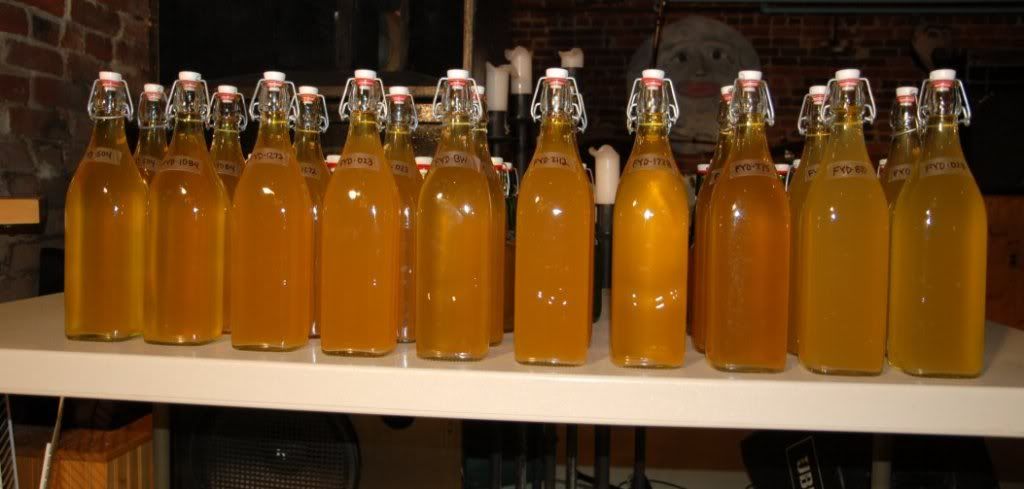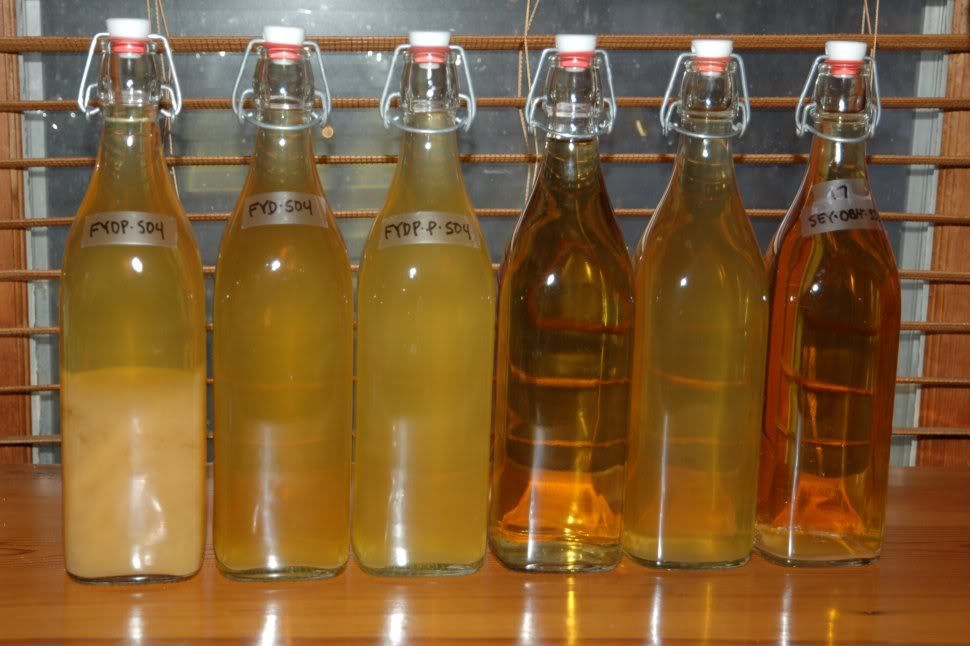This past week was fairly busy for ciderin'
I got all 22 of the latest experimenatal batches crashed and have bottled 10 of the new yeast experiments. The clarifier experiments are still crashing in the fridge.
I had to go out of town for work for a few days and a few of these got more dry than I wanted them to, but given the overall low acid, that was probably a good thing, because none of them were overly harsh, even though they've had zero aging.
The new yeast batches were all with unpasteurized juice. If these were keg batches, I would normally rack them again into another carboy and let them sit for a week or two after the crash to continue to clear before kegging, but for gallon batches, its generally not worth cleaning another bunch of jugs, so coming out of the fridge, I racked these right into botttles. Some of these have already cleared fairly well, but they will all likely continue to clear in the bottle and drop some sediment. The S04, Wy1084, Brewferm wheat and Wy1728 were the most clear after a few days of crashing. Its still early days, but they all tasted at least decent, and some fairly good going into to the bottle and will hopefully continue to improve. Here are some preliminary notes on the new yeast experiments, which left to right are as follows:
S04 (the control on this batch of juice) - crashed after 14 days at 1.006 tastes good, a little on the dry side, but good balance
Wyeast 1084 Irish Ale - crashed after 14 days at 1.002, a bit bland but nice finish
Wyeast 1272 American Ale II - crashed after 14 days at 1.004, starts dry but finishes nice, the jug swelled a bit during the crash, so may be a little harder to crash
White Labs WLP023 Burton Ale - crashed after 14 days at 1.006, smooth, nice appley finish, the jug swelled a bit during the crash, so may be a little harder to crash
Brewferm Blanche (dry wheat yeast) - crashed after 14 days at 1.002. Tastes sweeter than 1.002. I wish I had caught this one sooner, but overall I'd say this is the best tasting dry wheat yeast that I've worked with. Probably still not as good as the liquid wheat yeasts, but time will tell. Also came out the most clear after the crash, which I would not expect for a wheat yeast
Wyeast 2112 California Lager - crashed after 14 days at 1.008, tastes OK, although not as appley as I expected, considering fg was 1.008
Wyeast 1728 Scottish Ale - crashed after 14 days at 1.002, tastes sweeter than sg would indicate, nice finish
White Labs WLP775 English Cider - crashed after 14 days at 1.002, a bit bland but balance is OK
White Labs WLP810 San Francisco Lager - crashed after 16 days at 1.010, smells good, has a lot of citric acid up front, a bit yeasty and maybe some fusel alcohol taste. A little sweet in the finish, but the acid/sugar balance works
White Labs WLP028 Edinburgh Ale - crashed after 16 days at 1.008, smells good, big flavor up front, nice finish
still in the fridge:
White Labs WLP041 Pacific Ale - crashed after 21 days at 1.022, the fermentation seemed to be stuck for the past week. At first it was overly sweet, but then started slowly picking up a Malic Acid taste in the finish, which gave it enough zip to balance the sweetness, although SG didnt change. This could be an interesting one to experiment some more with
British yeast mix - crashed after 14 days at 1.000, decent flavor for so dry
Also still crashing in the fridge are the 10 UV-pasteurized batches that I am going to use for experimenting with different clarifiers. These 10 batches I will rack again before adding the clarifier.
Even though I havent added any of the clarifiers yet, there were some interesting differences between the 5 batches with pectin enzyme added ahead of time vs the 5 batches without the pectic enzyme:
The 5 batches with the pectic enzyme were a lot lighter in color, which I expected. What I didnt expect is that they also fermented quite a bit faster than the batches without the enzyme, and even a little bit faster than the gallon of unpasteurized juice, even though all 11 batches used the same S04 yeast. After 14 days, the 5 UV pasteurized batches with pectic enzyme were all at 1.004, while the 5 UV pasteurized batches without the enzyme were all at 1.008. The unpasteurized batch was at 1.006. I crashed all the batches with the enzyme, but it took another 4 days for the 5 batches without the enzyme to ferment down to 1.004 (I liked the taste a little better at 1.008, but wanted to crash these all at the same point so that when I added the clarifiers, the other factors (yeast, juice and FG) would be as consistent as possible).
I suspect that what is going on is that when the pectic enzyme breaks down the pectin, the result is extra nutrients which speeds the fermentation. Pasteurizing the juice sets the pectin, making it less available as nutrient, hence UV pasteurized juice with no pectin enzyme is a little slower than unpasteurized, but adding the pectic enzyme breaks down the pectin, making nutrients more available, hence the faster fermentation.
The pectic enzyme may also make the juice harder to crash, because all 5 of the jugs with the enzyme are noticably swollen after being racked and crashed for several days, while the batches without the enzyme seem to have stopped dead without any additonal swelling in the fridge - although to be fair, the batches with the enzyme have been in the fridge longer, so I'm going to let them all go a while longer to see if the batches without the enzyme eventually swell.
Finally, when I racked the pasteurized batches before the crash, the sediment in all 5 of the batches without the pectic enzyme was much more compact than the 5 gallons with the enzyme, and also much more compact than what I normally see with unpasteurized juice. All of the batches looked about the same from the outside, with about a half inch of sediment on the bottom and clear juice on top. For the batches with the enzyme, the sediment layer was similar to what I normally see with unpasteurized juice - a muddy but still somewhat fluid layer that you have to be careful not to syphon up with the clear layer into the fresh jug. The sediment in the untreated pasteurized juice was much more solid and I was able to get almost all the clear juice out without sucking any sediment up. When the jug was empty, the sediment on the bottom looked like a solid rubbery mass, with little craters and holes in it - sorta like a pancake looks before you flip it. The trub left in the jugs with the enzyme, looked more like muddy water. The net result was that on the pre-crash rack, I was able to get a good bit more clear juice from the jugs without the enzyme. I'm not sure why this would be the case, but something about the way the UV sets the pectin also makes the sediment much more compact and rubbery - even though the clear juice on top is not quite as clear. Strange.





